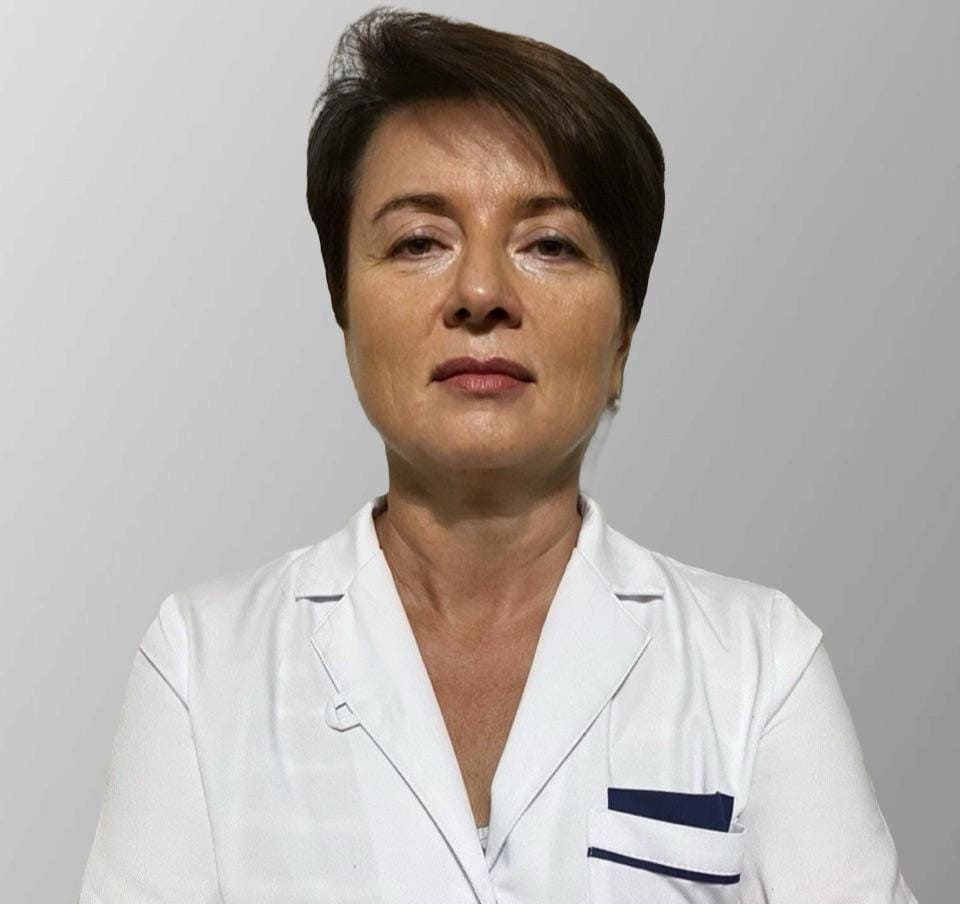
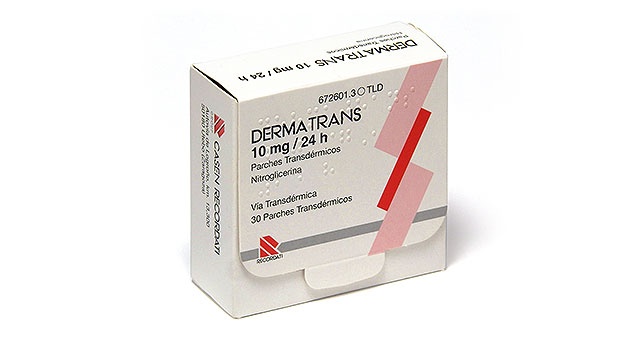
DERMATRANS 10 mg/24 h AUTOCLUSIVO TRANSDÉRMICO

Pergunte a um médico sobre a prescrição de DERMATRANS 10 mg/24 h AUTOCLUSIVO TRANSDÉRMICO

Como usar DERMATRANS 10 mg/24 h AUTOCLUSIVO TRANSDÉRMICO
Introdução
PROSPECTO:INFORMAÇÃO PARA O UTILIZADOR
Dermatrans 5 mg/24 h, patch transdérmico
Dermatrans 10 mg/24 h, patch transdérmico
Dermatrans 15 mg/24 h, patch transdérmico
Trinitrato de glicerilo
Leia todo o prospecto atentamente antes de começar a usar este medicamento, porque contém informações importantes para si.
- Conserva este prospecto, porque pode ter que voltar a lê-lo.
- Se tiver alguma dúvida, consulte o seu médico ou farmacêutico ou enfermeiro.
- Este medicamento foi prescrito para si e não deve dá-lo a outras pessoas, mesmo que tenham os mesmos sintomas, porque pode prejudicá-las.
- Se experimentar efeitos adversos informe o seu médico, farmacêutico ou enfermeiro, mesmo que se trate de efeitos adversos que não aparecem neste prospecto. Ver secção 4.
Conteúdo do prospecto:
- O que é Dermatrans e para que é utilizado
- O que precisa saber antes de usar Dermatrans
- Como usar Dermatrans
- Posíveis efeitos adversos
- Conservação de Dermatrans
- Conteúdo do envase e informação adicional
1. O que é Dermatrans e para que é utilizado
Os patches de Dermatrans contêm o princípio ativo trinitrato de glicerilo, um vasodilatador empregado em doenças cardíacas, que pertence a um grupo de fármacos chamados nitratos orgânicos.
Os patches de Dermatrans aplicam-se à pele e, em seguida, o princípio ativo passará de forma contínua através da sua pele para o interior do seu corpo.
Dermatrans está indicado para a prevenção de ataques de angina, seja só ou em combinação com outra terapia antianginosa.
A angina costuma manifestar-se como dor ou opressão no peito, embora possa sentir-se no pescoço ou no braço. A dor produz-se quando o coração não está suficientemente oxigenado. Dermatrans não está indicado para o tratamento dos ataques agudos. Para o tratamento dos ataques agudos deve utilizar o seu comprimido sublingual ou spray sublingual habitual.
Os patches de Dermatrans são exclusivamente para uso externo.
2. O que precisa saber antes de usar Dermatrans
Não useDermatrans:
- se si é alérgico ao princípio ativo ou a algum dos outros componentes deste medicamento (incluídos na secção 6).
- se si tem ou teve recentemente um choque associado a uma pressão sanguínea muito baixa;
- se si padece de dores de cabeça (cefaleias), vómitos ou convulsões associadas com um aumento da pressão intracraniana, incluindo os causados por um traumatismo craniano;
- se si sofre de insuficiência cardíaca devida a uma obstrução como, por exemplo, na presença de estreitamento do orifício aórtico ou orifício auriculoventricular do coração (estenose aórtica ou estenose mitral, respetivamente), ou de um engrossamento fibrótico da fina membrana, em forma de saco, que rodeia o coração (pericardite constrictiva);
- se si está a tomar medicamentos para o tratamento da disfunção erétil (p. ex., sildenafilo ou qualquer outro inibidor da PDE-5). Não devem ser administrados nitratos em pacientes tratados com sildenafilo ou qualquer outro medicamento empregado para tratar a disfunção erétil. Os pacientes que estão a receber atualmente nitratos não devem tomar sildenafilo ou qualquer outro medicamento para o tratamento da disfunção erétil. A combinação de um nitrato com sildenafilo ou qualquer outro inibidor da PDE-5 pode causar uma queda profunda e súbita da pressão arterial, que pode conduzir a desmaio, perda de consciência ou até um ataque cardíaco (ver também "Não use Dermatrans");
- se si está a tomar medicamentos que contenham riociguat, estimulador da guanilato ciclasa solúvel.
- se si padece uma grave baixa de tensão arterial (pressão sanguínea arterial máxima de 90 mm Hg);
- se si sofre um grave descenso do volume de sangue no seu organismo devido a perdas importantes de sangue ou perdas de outros fluidos do organismo (hipovolemia grave);
- se si padece uma anemia grave;
- se si tem retenção de fluidos tóxicos nos pulmões (edema pulmonar tóxico).
Advertências e precauções
Consulte o seu médico, farmacêutico ou enfermeiro antes de tomar Dermatrans:
- se retira o tratamento. A retirada do tratamento com Dermatrans deve ser gradual, mediante substituição por doses decrescentes de nitratos orais de ação prolongada;
- se si vai submeter-se a uma imagem por ressonância magnética, estimulação elétrica do seu coração para o restabelecimento do ritmo cardíaco normal (desfibrilhação ou cardioversão) e antes de um tratamento com calor (diatermia), si deve tirar o patch de Dermatrans antes de se submeter a estes tratamentos.
- se si tem ou teve recentemente um ataque cardíaco (infarto do miocárdio) ou se desenvolve rapidamente sintomas de insuficiência cardíaca (insuficiência cardíaca aguda) tais como dificuldade para respirar, sensação de muito cansaço, inchaço das pernas. O seu médico pode pedir-lhe que realize os exames de laboratório para ver a sua função cardiovascular.
- se si padece uma grave baixa de pressão arterial ou em caso de padecer um colapso ou um choque enquanto está sob tratamento com Dermatrans, o patch deve ser retirado;
- se si experimenta dor torácica (ataques anginosos agudos) ou se o seu coração não consegue suficiente fluxo sanguíneo e oxigénio (angina instável) ou em caso de ataque cardíaco (infarto do miocárdio). Dermatrans não deve ser usado como tratamento imediato para estas doenças.
- se si experimenta um dor de cabeça intenso ou uma pressão arterial anormalmente baixa (hipotensão). Isto pode ocorrer se a dose inicial for demasiado elevada. É aconselhável aumentar a dose gradualmente até que se alcance o efeito óptimo;
- se si está a tomar outros nitratos ou trinitrato de glicerilo sublingual, porque o seu organismo pode desenvolver uma resistência aos efeitos destas substâncias após a exposição repetida (tolerância cruzada);
- se si tem ou teve uma pressão arterial anormalmente baixa induzida pelo trinitrato de glicerilo. Neste caso, pode experimentar uma frequência cardíaca baixa (bradicardia paradójica) e aumento da angina;
- se si padece uma doença do nervo óptico (glaucoma de ângulo fechado);
- se si tem uma oxigenação insuficiente da sangue (hipoxemia) devido a anemia grave ou doença pulmonar ou redução do aporte sanguíneo ao seu coração (insuficiência cardíaca isquémica).
- Pacientes com estas condições médicas frequentemente sofrem um desequilíbrio de ventilação/perfusão que é um índice da função respiratória. Nestes pacientes, o trinitrato de glicerilo poderia piorar o desequilíbrio de ventilação/perfusão e causar uma maior diminuição da oxigenação sanguínea;
- se a angina está produzida pelo engrossamento do seu coração (miocardiopatia hipertrófica). Os nitratos podem piorar este tipo de angina;
- se si experimenta um aumento da frequência dos ataques anginosos durante os períodos sem patch. É possível que o seu médico deseje avaliar a possibilidade de uma terapia antianginosa adicional.
- Se si experimenta uma sensibilização da pele (picazón, queimadura, inflamação), deve interromper o tratamento e consultar o seu médico.
Uso de outros medicamentos
A administração simultânea de medicamentos para o tratamento da disfunção erétil (p. ex., sildenafilo ou qualquer outro inibidor da PDE-5) potencia os efeitos reductores da pressão arterial dos nitratos e, portanto, deve ser evitada (ver também "Não use Dermatrans”).
Deve ser evitado o tratamento simultâneo com riociguat, estimulador da guanilato ciclasa solúvel, porque o seu uso concomitante pode causar hipotensão (ver também "Não use Dermatrans”).
O tratamento simultâneo com
- Medicamentos utilizados para baixar a pressão arterial alta, como por exemplo, antagonistas do cálcio, inibidores da ECA (para o tratamento do fallo cardíaco congestivo), betabloqueantes (utilizados para manejar as arritmias cardíacas), diuréticos (aumentar a eliminação de água do corpo) e outros anti-hipertensivos,
- antidepressivos tricíclicos (medicamentos para o tratamento de distúrbios depressivos),
- neurolépticos (medicamentos utilizados para tratar a psicose) e
- tranquilizantes maiores (sedantes),
- assim como o consumo de álcool e com a associação de amifostina (medicamento citoprotectivo em quimio e radioterapia) e
- ácido acetil salicílico (um AINE),
pode potenciar os efeitos reductores da pressão arterial de Dermatrans.
O tratamento simultâneo com a dihidroergotamina pode reduzir o efeito de Dermatrans.
Os medicamentos anti-inflamatórios não-esteroides, excepto o ácido acetil salicílico, podem diminuir a resposta terapêutica de Dermatrans.
Informa ao seu médico ou farmacêutico se está a utilizar, utilizou recentemente ou poderia ter que utilizar outros medicamentos.
Fertilidade, gravidez e lactação
Dermatrans não deve ser utilizado na gravidez, especialmente nos três primeiros meses, a não ser que seja indicado pelo seu médico.
Devido à informação limitada sobre a presença de trinitrato de glicerilo no leite materno, não deve ser excluído o risco para o bebê. O seu médico decidirá se interromper a lactação materna ou o uso de Dermatrans.
Não há dados disponíveis sobre o efeito de Dermatrans na fertilidade humana.
Se está grávida ou em período de lactação, acredita que pode estar grávida ou tem intenção de ficar grávida, consulte o seu médico antes de utilizar este medicamento.
Condução e uso de máquinas
Especialmente no início do tratamento ou em caso de ajuste de dose, Dermatrans pode influir na sua capacidade para conduzir ou usar máquinas, porque pode diminuir o tempo de reação ou poderia raramente produzir hipotensão ao pôr-se em pé e tonturas, assim como em casos excepcionais, desmaio após uma sobredose.
Se si experimenta estes efeitos, não deve conduzir ou usar máquinas.
3. Como usar Dermatrans
Siga exatamente as instruções de administração deste medicamento indicadas pelo seu médico ou farmacêutico. Em caso de dúvida, consulte novamente o seu médico ou farmacêutico.
A dose recomendada é de um patch de Dermatrans uma vez ao dia. Deve aplicar o patch à sua pele cuidadosamente e mantê-lo durante 12-16 horas, depois deve retirar o patch e deixar um período livre de patch durante as 8-12 horas restantes. Deve mudar o seu patch de Dermatrans de acordo com as instruções dadas pelo seu médico. O seu médico indicar-lhe-á quanto tempo deve manter o patch na pele e a duração do intervalo sem patch.
Uso em crianças e adolescentes
Dermatrans não deve ser utilizado em crianças e adolescentes menores de 18 anos.
Durante quanto tempo deve usar Dermatrans
O tratamento com Dermatrans pode ser mantido durante vários anos, no entanto, o seu médico deve vê-lo periodicamente para decidir se continua com o tratamento ou muda a pauta terapêutica.
Como colocar o patch
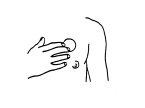 Deve aplicar o patch sobre a pele limpa e seca, evitando fazer isso sobre cortes, manchas ou imperfeições ou sobre uma área na qual se acabe de aplicar creme, um produto hidratante ou talco. Recomenda-se aplicar os patches transdérmicos de Dermatrans sobre a pele do peito (ver Figura 1) ou a parte superior externa do braço, em zonas sem vermelhidão ou irritação e ir mudando os lugares de aplicação. A área adequada pode ser afeitada, se necessário. Devem ser evitadas as áreas que formam dobras ou que estão sujeitas a fricção durante o movimento.
Deve aplicar o patch sobre a pele limpa e seca, evitando fazer isso sobre cortes, manchas ou imperfeições ou sobre uma área na qual se acabe de aplicar creme, um produto hidratante ou talco. Recomenda-se aplicar os patches transdérmicos de Dermatrans sobre a pele do peito (ver Figura 1) ou a parte superior externa do braço, em zonas sem vermelhidão ou irritação e ir mudando os lugares de aplicação. A área adequada pode ser afeitada, se necessário. Devem ser evitadas as áreas que formam dobras ou que estão sujeitas a fricção durante o movimento.
Figura 1
Não aplicar dois patches consecutivos no mesmo lugar.
Uma vez que se retire o patch de Dermatrans do invólucro, deve aplicá-lo imediatamente sobre a pele, como se explica a seguir:
(I) Abrir o invólucro pela muesca.
Não utilizar tesouras (ver Figura 2).

Figura 2
(II) Segurar o patch com o polegar e o
índice na pestaña que se desprenderá
(ver Figura 3).
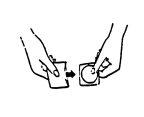 Figura 3
Figura 3
(III) Despegar a lâmina protetora com a outra
mão (ver Figura 4). Não toque o
lado adesivo do patch, porque se o fizer,
não se pegará bem.
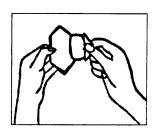
Figura 4
(IV) Aplicar a parte aberta do patch sobre a pele
e retirar a parte restante da lâmina
protetora. Pressionar firmemente durante uns 10 segundos sobre
a superfície inteira do patch. Passar outra vez os dedos por
os bordos do patch para se asegurar de que se pega firmemente.
Lave as mãos antes e depois de aplicar o Dermatrans.
Para retirar um patch, simplesmente despegue pelo bordo e puxe o patch suavemente até que se desprenda. Depois de o seu uso, dobre o patch ao meio, com a parte adesiva para dentro e atire-o num caixote onde as crianças não possam pegá-lo.
O que fazer se o patch se cair?
Se Dermatrans for aplicado corretamente, é muito pouco provável que o patch se caia. No entanto, se o patch se cair, mude-o por um novo e siga a pauta periódica habitual com o próximo patch.
Se usar mais Dermatrans do que devia
Se si se aplicar doses elevadas de trinitrato de glicerilo, pode experimentar uma grave baixa da pressão sanguínea, aumento do ritmo cardíaco ou colapso e desmaios, assim como alteração na hemoglobina (metahemoglobinemia).
Se si ou alguém lhe aplicar demasiados patches ao mesmo tempo, retire os patches cuidadosamente e lave a pele subjacente cuidadosamente para reduzir a absorção. Em caso de que si experimente baixa de pressão sanguínea ou colapso, recomenda-se que eleve ou, se necessário, aplique vendas de compressão nas pernas.
Se esquecer de mudar de patch
Se si esquecer de mudar o patch no momento correspondente, deve mudá-lo assim que possível e, em seguida, seguir a sua pauta periódica original aplicando o patch seguinte.
Se interromper o tratamento com Dermatrans
Quando deixar o tratamento com Dermatrans, pode experimentar uma recorrência dos ataques anginosos.
Se tiver alguma outra dúvida sobre o uso deste produto, pergunte ao seu médico, farmacêutico ou enfermeiro.
4. Posíveis efeitos adversos
Como todos os medicamentos, Dermatrans pode ter efeitos adversos, embora nem todas as pessoas os sofram.
Foram notificados os seguintes efeitos adversos:
Efeitos muito frequentes (que afetam mais de 1 paciente de cada 10 pacientes):
- Náuseas.
- Vómitos.
Efeitos adversos frequentes (que afetam entre 1 e 10 de cada 100 pacientes)
- Dor de cabeça.
Efeitos adversos pouco frequentes (que afetam entre 1 e 10 de cada 1.000 pacientes)
- Inflamação da pele por contato (dermatite de contato).
- Vermelhidão e irritação da pele no local de aplicação do patch.
- Picazón.
- Sensação de queimadura.
Efeitos adversos raros (que afetam entre 1 e 10 de cada 10.000 pacientes)
- Aumento do ritmo cardíaco (taquicardia).
- Diminuição da pressão sanguínea em posição de pé (hipotensão ortostática) que pode ser descrita como episódios transitórios de tonturas.
- Vermelhidão.
- Aumento do ritmo cardíaco como parâmetro analítico.
Efeitos adversos muito raros (que afetam menos de 1 de cada 10.000 pacientes)
- Tontura.
- Desmaio (síncope).
Efeitos adversos de frequência desconhecida:
- Latidos anormais do coração (palpitações).
- Erupção da pele generalizada (Erupção generalizada).
Comunicação de efeitos adversos
Se experimentar qualquer tipo de efeito adverso, consulte o seu médico, farmacêutico ou enfermeiro, mesmo que se trate de possíveis efeitos adversos que não aparecem neste prospecto. Também pode comunicá-los diretamente através do Sistema Espanhol de Farmacovigilância de Medicamentos de Uso Humano: https// www.notificaram.es. Mediante a comunicação de efeitos adversos, si pode contribuir para proporcionar mais informações sobre a segurança deste medicamento.
5. Conservação de Dermatrans
Mantenha este medicamento fora da vista e do alcance das crianças.
Não conserve a temperatura superior a 25°C. Dermatrans deve ser conservado no seu invólucro intacto.
Não utilize este medicamento após a data de caducidade que figura na caixa e nos invólucros. A data de caducidade é o último dia do mês que se indica.
Os medicamentos não devem ser atirados para os desgües nem para o lixo. Deposite os invólucros e os medicamentos que não precisa no Ponto SIGRE da farmácia. Em caso de dúvida, pergunte ao seu farmacêutico como se livrar dos invólucros e dos medicamentos que não precisa. Deste modo, ajudará a proteger o meio ambiente.
6. Conteúdo do envase e informação adicional
Composição de Dermatrans
Os patches de Dermatrans contêm o princípio ativo trinitrato de glicerilo e estão disponíveis em três concentrações:
Dermatrans 5 mg/24 h: contém 15,70 mg do princípio ativo trinitrato de glicerilo e libera cerca de 5 mg de trinitrato de glicerilo por dia (0,2 mg/h); a área de liberação do patch é de 6,38 cm2. O código de identificação impresso na lâmina é NR5.
Dermatrans 10 mg/24 h: contém 31,37 mg do princípio ativo trinitrato de glicerilo e libera cerca de 10 mg de trinitrato de glicerilo por dia (0,4 mg/h); a área de liberação do patch é de 12,75 cm2. O código de identificação impresso na lâmina é NR10.
Dermatrans 15 mg/24 h: contém 47,04 mg do princípio ativo trinitrato de glicerilo e libera cerca de 15 mg de trinitrato de glicerilo por dia (0,6 mg/h); a área de liberação do patch é de 19,12 cm2. O código de identificação impresso na lâmina é NR15.
Os outros ingredientes são uma substância adesiva (copolímero de acrilato-vinilacetato), um facilitador da aderência (ftalato de hidroabietilo) e um formador de ligações cruzadas (polímero de butiltitanato), que se têm estendido juntamente com o princípio ativo em uma lâmina (lâmina de polipropileno lacada). A camada adesiva está coberta por uma lâmina protectora aluminizada e siliconizada de duas faces, que se retira antes do uso.
Aspecto do produto e conteúdo do envase
Dermatrans são patches transdérmicos adesivos. Cada patch está fechado individualmente em um envelope protector.
Tamanhos dos envases: 15 e 30 patches. Pode ser que apenas alguns tamanhos de envases estejam comercializados.
Titular da autorização de comercialização e responsável pela fabricação
Titular da autorização de comercialização:
CASEN RECORDATI S.L.
Autovía de Logroño, km. 13,300 UTEBO
50180 (ZARAGOZA)
Responsável pela fabricação:
ROTTAPHARM LTD.
Damaastown, Industrial Park
15 Mulhuddart, County Dublin, Irlanda
ou
LTS Lohmann Therapie Systeme AG
Lohmannstraße 2
56626 Andernach
Alemanha
Este medicamento está autorizado nos estados membros do Espaço Económico Europeu com os seguintes nomes:
PaísNome
Irlanda Dermatrans
Itália Dermatrans
Espanha Dermatrans
Data da última revisão deste prospecto: dezembro 2022.
A informação detalhada e actualizada deste medicamento está disponível na página Web da Agência Espanhola de Medicamentos e Produtos Sanitários (AEMPS) http://www.aemps.gob.es/

Quanto custa o DERMATRANS 10 mg/24 h AUTOCLUSIVO TRANSDÉRMICO em Espanha em 2025?
O preço médio do DERMATRANS 10 mg/24 h AUTOCLUSIVO TRANSDÉRMICO em dezembro de 2025 é de cerca de 15.42 EUR. Os valores podem variar consoante a região, a farmácia e a necessidade de receita. Confirme sempre com uma farmácia local ou fonte online para obter informações atualizadas.
- País de registo
- Preço médio em farmácia15.42 EUR
- Substância ativa
- Requer receita médicaSim
- Fabricante
- Esta informação é apenas para referência e não constitui aconselhamento médico. Consulte sempre um médico antes de tomar qualquer medicamento. A Oladoctor não se responsabiliza por decisões médicas baseadas neste conteúdo.
- Alternativas a DERMATRANS 10 mg/24 h AUTOCLUSIVO TRANSDÉRMICOForma farmacêutica: ADESIVO TRANSDÉRMICO, 37,4 mg de nitroglicerinaSubstância ativa: glyceryl trinitrateFabricante: Merus Labs Luxco Ii S.À.R.L.Requer receita médicaForma farmacêutica: ADESIVO TRANSDÉRMICO, 18,7 mg de nitroglicerinaSubstância ativa: glyceryl trinitrateFabricante: Merus Labs Luxco Ii S.À.R.L.Requer receita médicaForma farmacêutica: ADESIVO TRANSDÉRMICO, 47,04 mgSubstância ativa: glyceryl trinitrateFabricante: Casen Recordati S.L.Requer receita médica
Alternativas a DERMATRANS 10 mg/24 h AUTOCLUSIVO TRANSDÉRMICO noutros países
As melhores alternativas com o mesmo princípio ativo e efeito terapêutico.
Alternativa a DERMATRANS 10 mg/24 h AUTOCLUSIVO TRANSDÉRMICO em Polónia
Alternativa a DERMATRANS 10 mg/24 h AUTOCLUSIVO TRANSDÉRMICO em Ukraine
Médicos online para DERMATRANS 10 mg/24 h AUTOCLUSIVO TRANSDÉRMICO
Avaliação de posologia, efeitos secundários, interações, contraindicações e renovação da receita de DERMATRANS 10 mg/24 h AUTOCLUSIVO TRANSDÉRMICO – sujeita a avaliação médica e regras locais.





